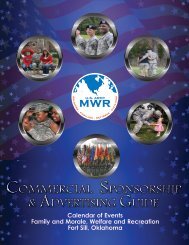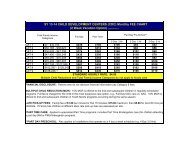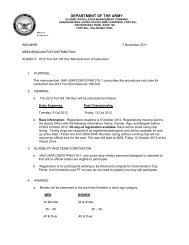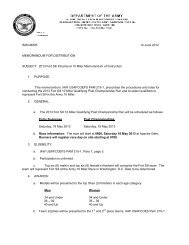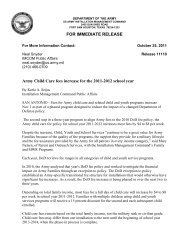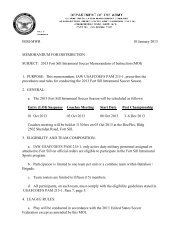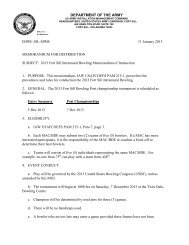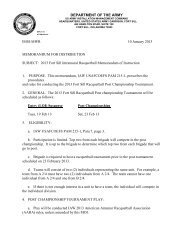Preparing and Managing Correspondence - Fort Sill MWR
Preparing and Managing Correspondence - Fort Sill MWR
Preparing and Managing Correspondence - Fort Sill MWR
You also want an ePaper? Increase the reach of your titles
YUMPU automatically turns print PDFs into web optimized ePapers that Google loves.
6–5. Personnel on active duty<br />
a. Name. Sign the name plainly <strong>and</strong> legibly. It must be identical with the typewritten, stamped, or printed name.<br />
b. Social security number. Use social security numbers in accordance with the guidelines of the Privacy Act of 1974<br />
or as otherwise directed by this regulation.<br />
c. Rank. The rank will be that in which served (for example, Colonel, Lieutenant Colonel, <strong>and</strong> Major). For<br />
chaplains, put the rank in parentheses <strong>and</strong> precede it with the word “Chaplain.” For example:<br />
J. JONES<br />
Chaplain (CPT) USA<br />
(1) In preparing general officer signature blocks, it is preferable to spell out the rank. When using abbreviations in<br />
any signature block for other than general officers, use only the abbreviations (for example, LTC, MAJ, <strong>and</strong> so forth).<br />
On military correspondence, rank abbreviations are optional. Abbreviations may also be used in the text of all military<br />
correspondence when referring to an individual by rank.<br />
(2) Do not use the “(P)” (meaning that the signer is promotable) as part of a signature block on Army correspondence<br />
unless it benefits or enhances the image of the Army. However, it may be used in an address for such things as<br />
congratulatory notes.<br />
(3) General officers will use the designation “USA” except as indicated in (4) <strong>and</strong> (5) below. Write “US Army” (not<br />
“USA”) on letters.<br />
(4) General officers detailed to duty in general staff positions will use the designation “GS.” Do not use the<br />
designation “GS” on letters; use “US Army.”<br />
(5) General officers serving in a branch of the Army Medical Service will use the abbreviations of the branch in<br />
which they are serving (for example, MC, DC) except as indicated in (4) above.<br />
(6) Warrant officers will use the designation “USA” except where a branch title is authorized. Reserve warrant<br />
officers on active duty will use the designation “USA.” Army National Guard warrant officers will use the designation<br />
“ARNGUS.”<br />
(7) For chaplains, the designation “USA” will follow the rank, for example, Chaplain (MAJ) USA.<br />
(8) Officers assigned or detailed as general staff officers <strong>and</strong> officers in the rank of colonel or below detailed as<br />
inspectors general will use the designation “GS” or “IG” as appropriate.<br />
(9) Officers assigned or detailed to the headquarters of a joint comm<strong>and</strong> or agency will use only the Service<br />
designation “USA.” Otherwise, use “US Army” in place of branch designation.<br />
(10) Branch designation should be used on letters only when necessary for credibility. For example, use Medical<br />
Corps or Chaplain on matters that would require the attention of the medical profession or the clergy.<br />
(11) Army National Guard personnel not on active duty will use the two-letter State or territory abbreviation of their<br />
unit followed by “ARNG,” for example, KSARNG (Kansas Army National Guard personnel).<br />
d. Organization. In some cases the organization may be shown in the signature block. This will often be the case<br />
when the signer’s organization is not included in the letterhead or elsewhere in the correspondence. Show the<br />
organization as the final element of the signature block.<br />
e. Title.<br />
(1) When an individual is serving in an acting capacity, use a title that reflects the acting status, for example, Acting<br />
Comm<strong>and</strong>er, Acting The Adjutant General, Acting Transportation Officer, <strong>and</strong> Acting Post Engineer.<br />
(2) When an individual occupies more than one position, use the title that is most appropriate to the message that he<br />
or she is signing, for example, E.D. White, Colonel, AG, Director, Staff Support; E.D. White, Colonel, AG, Secretary,<br />
Retirement Board.<br />
(3) When the signer writes about himself or herself, do not use a title.<br />
6–6. Retired military personnel<br />
Retired military should follow the same rules as active personnel, except that no organization or branch of the Army<br />
will be shown. Show retired status after the rank as follows:<br />
a. All Regular Army personnel retired for Service, age, or physical disability, including Regular Army personnel on<br />
the Temporary Disability Retired List will use “USA Retired,” for example, A.B. Smith, COL (USA Retired).<br />
b. All personnel on the Army of the United States Retired List, including nonregular Army personnel on the<br />
Temporary Disability List, will use “AUS Retired,” for example, A.B. Smith, COL (AUS Retired).<br />
c. All personnel on the Officers Honorary Retired List will use “AUS Retired (Hon).”<br />
d. All Army reservists assigned to USAR Control Group (Retired), except those referred to in b above, will use<br />
“USAR Retired.”<br />
e. Army retirees serving as DA civilians will not use or refer to their military grade or rank except when referring to<br />
their personal retirement actions.<br />
50 AR 25–50 • 3 June 2002




